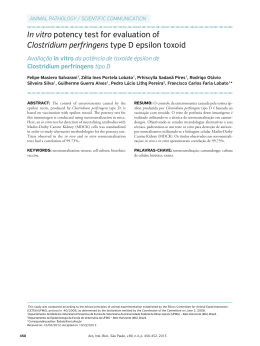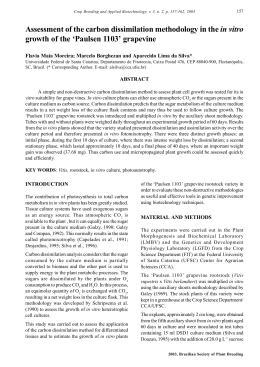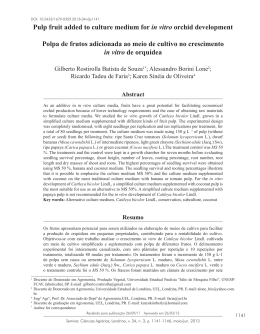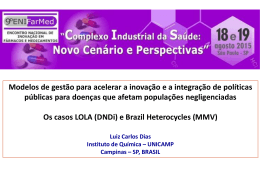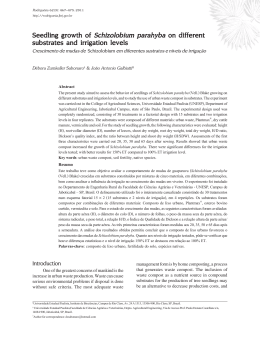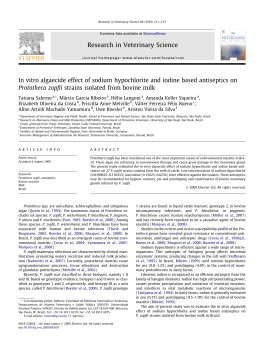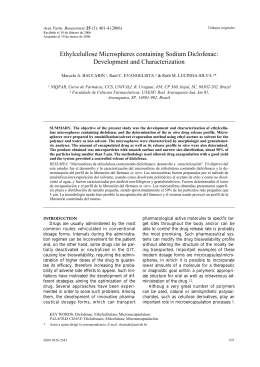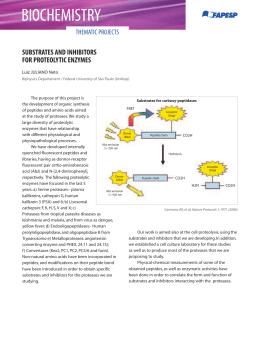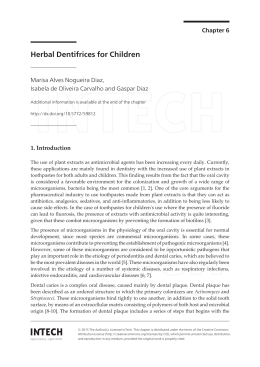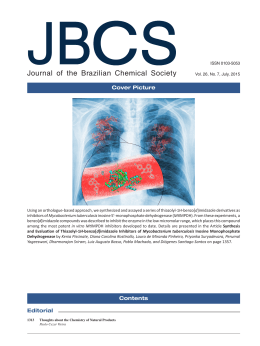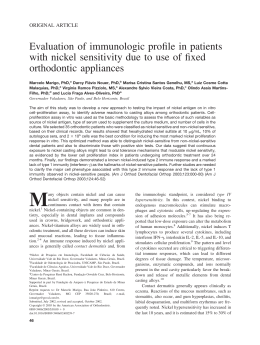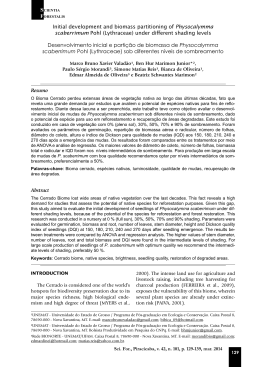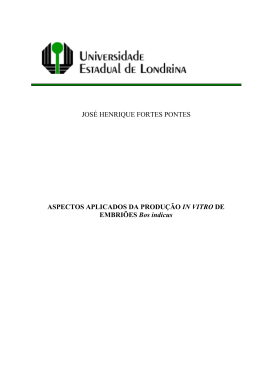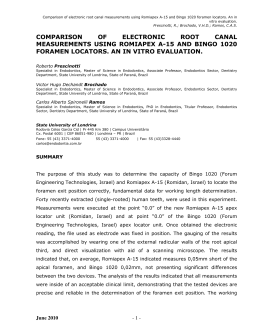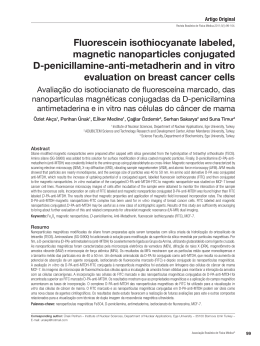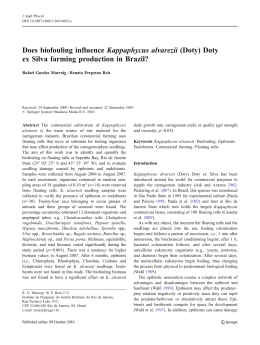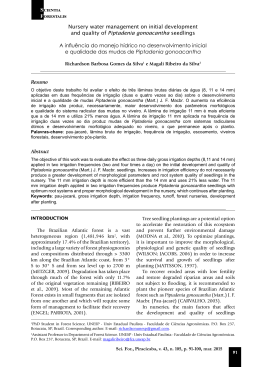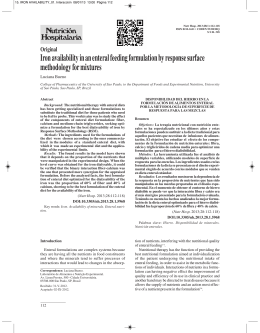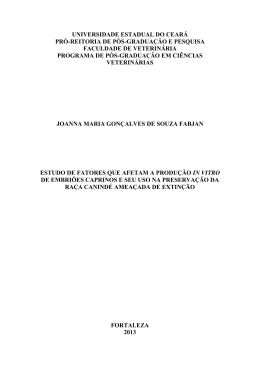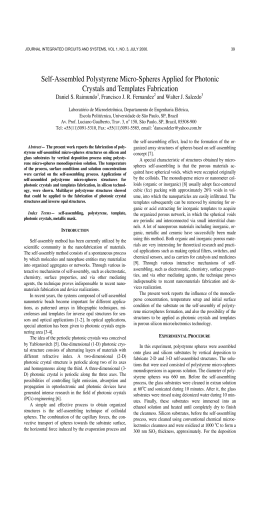Australian Journal of Basic and Applied Sciences, 8(7) May 2014, Pages: 257-264 AENSI Journals Australian Journal of Basic and Applied Sciences ISSN:1991-8178 Journal home page: www.ajbasweb.com Anatomical analyses of acclimatization process Tabebuia roseo-alba (Bignoniaceae) seedlings during 1 Jorge Marcelo Padovani Porto, 2Patrícia Duarte de Oliveira Paiva, 3Francyane Tavares Braga, 4Paulo Augusto Almeida Santos, 5Renato Paiva, 5Evaristo Mauro de Castro Department of Agriculture, Universidade Federal dos Vales do Jequitinhonha e Mucuri-UFVJM, Diamantina-MG – Brazil Department of Agriculture, Universidade Federal de Lavras-UFLA, Lavras-MG - Brazil 3 Department of Education, Universidade Estadual da Bahia – UNEB, Paulo Afonso-Bahia –Brazil 4 Department of Chemistry, Universidade Federal de Lavras-UFLA,Lavras-MG – Brazil 5 Department of Biology, Universidade Federal de Lavras-UFLA, Lavras-MG – Brazil 1 2 ARTICLE INFO Article history: Received 2 February 2014 Received in revised form 8 April 2014 Accepted 28 April 2014 Available online 25 May 2014 Keywords: leaf anatomy, epidermis, stomata, substrates. ABSTRACT The knowledge on morphological changes of plants grown in vitro is essential for establishing effective protocols for the survival of plants from controlled environments under natural conditions. This study aimed to examine the acclimatization of ipê-branco seedlings produced in vitro and also to compare the anatomical structure between leaves of seedlings grown in vitro and those acclimatized to different substrates. For acclimatization, ipê-branco seedlings were taken from in vitro cultivation and transferred to tubes containing Plantmax TM, vermiculite, sand and Plantmax TM + vermiculite + sand mixture. About 100% of fixation was verified, and seedlings acclimatized in Plantmax TM were those showing the best development. For the anatomical study, transversal and paradermal sections were performed in the leaf blades of seedlings derived from in vitro cultivation and seedlings already acclimatized to the different substrates. Anatomical differences were observed in the leaf blades of seedlings from the in vitro environment when compared to those acclimatized to different substrates. The stomatal density and polar and equatorial diameter of leaves derived from the in vitro environment were higher than those acclimatized to different substrates. The PD / ED ratio was lower for leaves derived from the in vitro environment, and comparing the different substrates, it was greater in seedlings acclimatized with vermiculite. The mesophyll and adaxial and abaxial epidermises were smaller in plants grown in vitro and among substrates, seedlings acclimatized to Plantmax TM were higher, with increased thickness of palisade and spongy parenchyma. © 2014 AENSI Publisher All rights reserved. To Cite This Article: Jorge Marcelo Padovani Porto, Patrícia Duarte de Oliveira Paiva, Francyane Tavares Braga, Paulo Augusto Almeida Santos, Renato Paiva, Evaristo Mauro de Castro, Anatomical analyses of Tabebuia roseo-alba (Bignoniaceae) seedlings during acclimatization process. Aust. J. Basic & Appl. Sci., 8(7): 257-264, 2014 INTRODUCTION Acclimatization is defined as the process of transferring a seedling from the in vitro condition to the natural environment or to an intermediate environment, like a greenhouse (Debergh & Maeno, 1981; Shin, et al., 2014). Some species are easy to adapt, showing 100% survival rate, while others have difficulties in this process. The main cause of low survival rate is the excessive loss of water by plants during this process (Sutter & Lamghans, 1982). There are various mixtures used in the composition of substrates for plants that are submitted to acclimatization process, and the selection should take into consideration physicochemical and hydric properties, as these influences the water / air ratio of the substrate and nutrient availability and absorption (Fernandes & Corá, 2000; Freitas, et al., 2011). The use of different substrates with effective results for the acclimatization of various plants has been verified by several authors (Vichiato, et al., 1998; Brasil, et al., 1999; Sediyama, et al., 2000; Souza, 2001; Mendonça, et al., 2003), as well as for the development of seedlings (Luz, et al., 2007; Ferreira, et al., 2007; Almeida, et al., 2008). Some histological studies have demonstrated that vegetative organs of plants grown in vitro environments have poorly differentiated tissues and structures when compared to plants cultivated in greenhouses (Louro, et al. 2003; Apóstolo, et al. 2005; Saez, et al., 2012). Moreover, the number and shape of stomata are also affected, which can lead to a greater or lesser photosynthetic efficiency of plants (Osorio, et al., 2005). In ipêCorresponding Author: Jorge Marcelo Padovani Porto, Department of Agriculture, Universidade Federal dos Vales do Jequitinhonha e Mucuri-UFVJM, Rodovia MGT 367 - Km 583, nº 5000, Alto da Jacuba CEP 39100-000, Diamantina-MG – Brazil. Tel: +553835328583 E-mail: [email protected] 258 Jorge Marcelo Padovani Porto et al, 2014 Australian Journal of Basic and Applied Sciences, 8(7) May 2014, Pages: 257-264 branco leaves grown in vitro, cuticle and sclerenchyma are absent. However, plants grown ex vitro show not only these structures, but also higher thickest in relation to the leaf limb, midrib, the abaxial and adaxial epidermises and palisade and spongy parenchyma, as well as fewer stomata and higher number of trichomes when compared to plants grown in vitro (Abbade, et al., 2009). This study aimed to evaluate the acclimatization of ipê-branco seedlings produced in vitro and also to compare the anatomical characteristics of leaves grown in vitro with those acclimatized. MATERIAL AND METHODS Plants grown in vitro were obtained by seed germination on MS medium (Murashige & Skoog, 1962) added of 0.5 mg L-1 GA3. After 30 days, they were transferred to polyethylene tubes with capacity of 288 cm3, and filled with the following substrates: sand, PlantmaxTM and vermiculite, and a mixture of PlantmaxTM: vermiculite: sand (P.V.S.) at a ratio of 1:1:1. Seedlings were kept in growth room and covered with transparent plastic bags and tubes were partially immersed in distilled water. The plastic covering was gradually perforated during 30 days, being then fully removed. The plants were kept under 16-hour photoperiod and photon irradiance of 55 µmol m-2 s-1and temperature of 27 ± 2 º C. To perform the anatomical analysis, fully expanded leaves were collected from the upper third of ipêbranco seedlings after 30 days of acclimatization and from plants grown in vitro. Both were fixed in 70% FAA (formaldehyde - glacial acetic acid - 70% ethyl alcohol) for 72 hours and then preserved in 70% ethanol (Johansen, 1940). The anatomical study of leaves was based on microscopic examination of cross sections, obtained with manual microtome, and of paradermal sections from abaxial and adaxial surfaces of leaves, obtained by hand, both from the median region of leaves. The cross sections were clarified with 50% sodium hypochlorite, rinsed in distilled water, stained with astra blue and safranin and mounted in 50% glycerol, according to methodology described by Kraus & Arduin (1997). Measurements of tissue thickness were performed with ocular micrometer coupled to light microscope. Slides with paradermal sections of abaxial and adaxial surfaces of leaves were mounted with a dye solution of 1% safranin in glycerol-water solution. Counting the number of stomata was performed on OLYMPUS CBB microscope. The stomatal density was expressed as the number of stomata per mm2, according to technique of Labouriau, et al. (1961). The thickness of palisade and spongy parenchyma, the adaxial and abaxial epidermises of leaves, as well as the polar and equatorial diameter of the stomata and the stomatal density of ipê-branco leaves were determined. The thickness, stomatal density and polar and equatorial diameter measurements of the stomata were conducted using completely randomized design with five replicates per treatment. Each replication consisted of three measurements for thickness, four for stomatal density and four for polar and equatorial diameter. After 30 days of acclimatization, number of leaves, root length and shoots we assessed. Data were analyzed using the SISVAR software (Ferreira, 2003) and results were compared by the Tukey test with 5% probability. For microscopy analyzes fifteen measurements were performed, the values were analyzed by Skott Knott test with 5% probability. Results: Acclimatized plants showed 100% survival rate in all substrates, which did not affect the shoot length of plants, but affected the root length and number of leaves (Table 1). Table 1: Effect of different substrates on the shoot length, root length and number of leaves of ipê-branco at 30 days of acclimatization. Substrates Survival rate (%) Shoot length (cm) Root length (cm) Number of leaves Sand 100 a 5.46 a 5.51 b 9.0 a PlantmaxTM 100 a 6.30 a 19.73 a 7.6 ab Vermiculite 100 a 5.76 a 15.57 a 6.4 b P.V.S.1 100 a 6.82 a 17.67 a 7.4 ab Means followed by same letter in columns do not differ significantly by Tukey test at 5%. 1 P.V.S. = Plantmax TM + vermiculite + sand. In plants acclimatized in substrates Plantmax TM and P.V.S., larger leaves were formed, as can be seen in Figure 1A and B. In plants acclimatized in vermiculite, the occurrence of necrosis in leaves was observed (Figure 1C). The root length was significantly affected for plants acclimatized in sand; however, this substrate showed the formation of higher number of leaves (9), in cases similar to that observed in plants acclimatized in substrates Plantmax TM and P.V.S. In addition, despite the smaller size of the root system, acclimatization in sand did not affect the shoot length. Plants acclimatized in vermiculite showed lower leaf formation. However, the substrate did not influence the shoot length or root length, which did not differ from plants grown in substrates Plantmax TM and P.V.S. 259 Jorge Marcelo Padovani Porto et al, 2014 Australian Journal of Basic and Applied Sciences, 8(7) May 2014, Pages: 257-264 Fig. 1: Appearance of ipê-branco plants after 30 days of acclimatization. Anatomical Analyses: Analyzing the paradermal sections of ipê-branco leaves, the presence of stomata was verified only on the abaxial epidermis of leaf blades, both for plants grown in vitro, and for those acclimatized to different substrates, featuring ipê-branco as a hypostomatic species. However, they show differences in shape. Figure 2 shows that the stomata of acclimatized plants showed elliptical shape (BCDE), while stomata of leaves produced in vitro (A) showed more circular shape. Fig. 2: Photomicrograph of paradermal sections of ipê-branco leaves grown in vitro (A) and acclimatized in sand (B), PlantmaxTM (C), P.V.S. (D) and vermiculite (E). Bar = 10 μm. 260 Jorge Marcelo Padovani Porto et al, 2014 Australian Journal of Basic and Applied Sciences, 8(7) May 2014, Pages: 257-264 Comparing the paradermal sections of plants produced in vitro with those acclimatized to different substrates, higher stomatal density was observed in plants grown in vitro, with average of 345.33 stomata per mm2. Among the acclimatized plants, the stomatal density was low, and substrate sand provided the formation of large number of stomata per leaf area, as shown in Figure 3. 400 a Stomatal density (mm-2) 350 300 250 200 b c 150 c c 100 50 0 In vitro Sand Vermiculite Plantmax P.V.S. P.V.A. Fig. 3: Stomatal density of abaxial epidermal tissue of ipê-branco leaf blades grown in vitro and acclimatized to different substrates for 30 days. Means followed by same letter do not differ significantly by the ScottKnott test at 5% significance level. The polar diameter of stomata was greater in seedlings grown in vitro and acclimatized in vermiculite. The equatorial diameter was also greater in stomata of seedlings grown in vitro, and no difference between stomata of acclimatized plants was observed. The highest (PD / ED) ratio occurred in plants acclimatized in vermiculite, 1.83 μm, while the lowest was observed in plants grown in vitro (1.26 μm) (Figure 4). 35 a Diameter stomata (μm) 30 25 a b b c a In vitro 20 b b b Vermiculite b Plantmax 15 Sand P.V.A. P.V.S. 10 5 c a b b b 0 Polar diameter Equatorial diameter Relationship PD/ED Fig. 4: Polar diameter (PD) and equatorial diameter (ED) and (PD / ED) ratio of stomata of abaxial epidermal tissue of ipê-branco leaf blades grown in vitro and acclimatized to different substrates for 30 days. Means followed by same letter for each group of bars do not differ significantly by the Scott-Knott test at 5% significance level. 261 Jorge Marcelo Padovani Porto et al, 2014 Australian Journal of Basic and Applied Sciences, 8(7) May 2014, Pages: 257-264 Analyzing the cross sections, both leaves grown in vitro and those acclimatized to different substrates showed dorsiventral organization, as shown in Figure 5. The cross sections showed that in all culture conditions, both epidermises consisted of only one cell layer, being characterized as unistratified epidermis (Figure 5). Fig. 5: Photomicrograph of cross sections of ipê-branco leaves acclimatized in Plantmax vermiculite (C), and sand (D) and those grown in vitro (E). Bar = 10 μm. TM (A), P.V.S. (B), The cuticle thickening was lower in leaves of plants grown in vitro in relation to acclimatization. The spongy parenchyma of plants grown in vitro showed 2 to 3 cell layers and smaller intercellular spaces when compared to tissues of acclimatized plants, where 3 to 4 cell layers were observed. The palisade parenchyma consists of only one layer, and the cells of acclimatized plants were more elongated and juxtaposed in relation to that observed in seedlings derived from in vitro environments (Figure 5). The thickness of the adaxial and abaxial epidermises and the mesophyll (Figure 6), besides the palisade and spongy parenchyma (Figure 7) were higher in plants acclimatized to Plantmax TM, differing from the other treaTMents. Smaller thicknesses were observed in plants grown in vitro (Figure 6 and 7). 120 a 100 b Thickness (μm) c c 80 d P.V.A. P.V.S. Vermiculite 60 Sand 40 20 Plantmax In vitro a b b c d a b b c d Adaxial epiderm Abaxial epiderm 0 Mesophyll Fig. 6: Adaxial and abaxial epidermises and mesophyll of ipê-branco leaves grown in vitro and acclimatized to different substrates for 30 days. Means followed by same letter for each group of bars do not differ significantly by the Scott-Knott test at 5% significance level. 262 Jorge Marcelo Padovani Porto et al, 2014 Australian Journal of Basic and Applied Sciences, 8(7) May 2014, Pages: 257-264 90 a 80 Thickness (μm) 70 b 60 c c c 50 P.V.A. P.V.S. Vermiculite 40 a 30 Plantmax Sand b b b In vitro c 20 10 0 Palisade parenchyma Spongy parenchyma Fig. 7: Thickness of the palisade and spongy parenchyma of ipê-branco leaves grown in vitro and acclimatized to different substrates for 30 days. Means followed by same letter for each group of bars do not differ significantly by the Scott-Knott test at 5% significance level. Discussion: In the acclimatization of pineapple variety Pérola, Moreira (2006) observed that, in relation to plant height, root length and number of leaves, substrate Plantmax TM was the best substrate, having been enriched with soil and manure. In this study, it was observed that substrates Plantmax TM and Plantmax TM + vermiculite + sand mixture provided better development of shoots, roots and higher number of leaves in acclimatized ipê-branco plants. According to Gislerod (1982) and HarTMann, et al. (1990), the substrate must have good water retention capacity, optimum amount of pore spaces filled with gases and adequate oxygen diffusion rate for root respiration. Plantmax TM presents physical (porosity, texture, drainage and low compression) and chemical characteristics (presence of nutrients and pH suitable for plant development) adequate for the growth of seedlings and emission of adventitious roots (Hoffman, et al., 2001). El-Bahr, et al. (2003) also found lower PD / ED ratio for stomata of plants grown in vitro when compared with acclimatized plants. According to Abbade, et al. (2009) circular-shaped stomata and lower DP / DE ratios were observed in ipê-branco seedlings grown in vitro, explaining the lower stomatal function in plants grown in vitro. According to Metcalfe & Chalk (1950), all Bignoniaceae species are dorsiventral, and isobilateral structure was only recorded in genus Kigelia. According to Alquini, et al. (2003), the cuticle thickening provides a natural protection against the action of solar radiation. The presence of stellate trichomes was verified on both epidermises, in all treaTMents. In yellow-ipe, the same differences were also observed in the palisade parenchyma when plants grown in vitro were compared to those acclimatized (Dousseau, et al., 2008). According to Lee, et al. (2000), more elongated palisade cells are an adaptation of plants to the high light intensity, thus justifying the presence of more cell layers in acclimatized plants. The lower mesophyll differentiation and smaller thickness of palisade and spongy parenchyma are changes often observed in plant grown in vitro when compared to ex vitro (Louro, et al., 2003). The tissue differentiation is an important factor in the light absorption process, especially in the mesophyll structure. It is expected that, the thicker the palisade parenchyma, the higher the photosynthetic rates (Bolhar-Vordenkampf & Draxler, 1993; Saez, et al., 2012), which is an essential process to plant growth and development. Conclusions: For acclimatization of ipê-branco seedlings, the use of Plantmax TM as substrate is recommended. The mesophyll, adaxial and abaxial epidermises and palisade and spongy parenchyma were thicker in plants acclimatized in Plantmax TM when compared to other substrates and to plants grown in vitro. 263 Jorge Marcelo Padovani Porto et al, 2014 Australian Journal of Basic and Applied Sciences, 8(7) May 2014, Pages: 257-264 The PD / ED ratio of stomata is higher in leaves acclimatized in vermiculite and lower in leaves grown in vitro. ACKNOWLEDGMENTS We thank the CNPq, FAPEMIG and CAPES, for the financial support. REFERENCES Abbade, L.C., P.D.O. Paiva, R. Paiva, E.M. Castro, A.R. Centofante and C. OLIVEIRA, 2009. Anatomia foliar de ipê-branco (Tabebuia roseo Alba (Ridl.) Sand.) Bignoniaceae, proveniente do cultivo ex vitro e in vitro. Acta Scientiarum. Biological Sciences, 31: 307-311. Almeida, E.F.A., P.B. Luz, M.A. Lessa, P.D.O. Paiva, J.B. Albuquerque and M.V.C. Oliveira, 2008. Diferentes substratos e ambientes para enraizamento de mini-ixora (Ixora coccinea 'Compacta'). Ciência e Agrotecnologia, 32(5): 1449-1453. Alquini, Y., C. BONA, M.R.T. BOEGER, C.G. COSTA and C.F. BARROS, 2003. Epiderme. In: B. APPEZZATO-DAGLÓRIA,S.M. CARMELLO-GUERREIRO, (Ed.). 2003. Anatomia vegetal. Viçosa, MG: UFV, pp: 87-108. Apóstolo, N.M., C.B. BRUTTI, LLORENTE, B.E. Leaf anatomia of Cynara scolymus, 2005. in successive micropropagation stages. In vitro Cell Developmental Biological - Plant, Columbia, 41: 307-313. Bolhar-Vordenkampf, H.R. and G. Draxler. Funcional leaf anatomy photosynthesis and production in a changing environment: a field and laboratory manual. London: Chapman & Hall, 1993. Brasil, E.C., A.M.B. Silva, C.H. Muller and G.R. Silva, 1999. Efeito da adubação nitrogenada e potássica e do calcário no desenvolvimento de mudas de aceroleira. Revista Brasileira de Fruticultura, 21(1): 52-56. Debergh, P.C. and L.J.A. MAENE, 1981. Scheme for commercial propagation of ornamental plats by tissue culture. Scientia Horticulture, 14(4): 335-345. Dousseau, S., A.A. Alvarenga, E.M. Castro, R.P. Soares, E.B. Emrich and L.A. Melo, 2008. Leaf anatomy of Tabebuia serratifolia (Vahl) Nich. (Bignoniaceae) propagated in vitro, in vivo and during the acclimatization. Ciencia e Agrotecnologia, 32(6): 1694-1700. El-Bahr, M.K., Z.A. Ali and H.S. Taha, 2003. In vitro propagation of Egyptian date palm cv. Zaghlool: II. comparative anatomical studies between direct acclimatized and in vitro adapted (pre-acclimatized) plantlets. Arab Universities Journal of Agricultural Sciences, 11(2): 701-714. Fernandes, C. and J.E. Corá, 2000. Caracterização físico-hídrica de substratos utilizados na produção de mudas de espécies olerícolas e florestais. Horticultura Brasileira, 18: 469-471. Ferreira, C.A., P.D.O. Paiva, T.M. Rodrigues, D.P. Ramos, J.G. Carvalho and R. Paiva, 2007. Desenvolvimento de mudas de bromélia (Neoregelia cruenta (R. Graham) L. B. Smith) cultivadas em diferentes substratos e adubação foliar. Ciência e Agrotecnologia, 31(3): 666-671. Ferreira, D.F. Sistemas de análises estatísticas para dados balanceados, 2003. Lavras: UFLA/ DEX/ SISVAR. pp: 145. Freitas, S.J., A.J.C. Carvalho, S.S. Berilli, P.C. Santos and C.S. Marinho. 2011. Substratos e osmocote ® na nutrição e desenvolvimento de mudas micropropagadas de abacaxizeiro cv. Vitória. Revista Brasileira de Fruticultura E: pp: 672-679. Gislerod, H.R., 1982. Physical conditions of propagation media and their influence on the rootins of cuttings: I. air content and oxygen diffusion at different moisture tensions. Plant and Soil, 69(3): 445-456. HarTMann, H.T., D.E. Kester, and F.T. Davies Júnior, 1990. Plant propagation: principles and practices. 5. ed. Englewood Cliffs: Prentice Hall, pp: 642. Johansen, D.A., 1940. Plant microtechnique. New York: McGraw-Hill,. pp: 523. Kraus, J.E. and M. ARDUIN, 1997. Manual básico de métodos em morfologia vegetal. Rio de Janeiro: EDUR,. pp: 198 . Labouriau, L.G., J.G. Oliveira and M.L. Salgado-Labouriau, 1961. Transpiração de Schizolobium parahyba (Vell.) Toledo: I. comportamento na estação chuvosa, nas condições de Caeté, Minas Gerais. Anais da Academia Brasileira de Ciências, 33(2): 237-257. Lee, D.W., S.F. Oberbauer, P. Johnson, B. Krishnapilay, M. Mansor, H. Mohamad and S.K. Yap, 2000. Effects of irradiance and spectral quality on leaf structure and function in seedlings of two Southeast Asian Hopea (dipterocarpaceae) species. American Journal of Botany, 87(4): 447-455. Louro, R.P., L.J.M. Santiago, A.V. Santos and R. D. Machado, 2003. Ultrastructure of Eucalyptus grandis x E.urophylla plants cultivated ex vitro in greenhouse and field conditions. Trees, 17(1): 11-22. Luz, P.B., P.D.O. Paiva, and P.R.C. Corrêa, 2007. Influência de diferentes tipos de estacas e substratos na propagação assexuada de hortênsia (Hydrangea macrophylla (Thunb.) Ser.) Ciência e Agrotecnologia, 31(3): 699-703. 264 Jorge Marcelo Padovani Porto et al, 2014 Australian Journal of Basic and Applied Sciences, 8(7) May 2014, Pages: 257-264 Mendonça, V., S.E. Araújo Neto, J.D. Ramos, R. Pio and T.C.A. Gontijo, 2003. Diferentes substratos e recipientes na formação de mudas de mamoeiro 'Sunrise Solo’. Revista Brasileira de Fruticultura, 25(1): 127130. Metcalfe, C.R. and L. Chalk, 1950. Anatomy of the dicotyledons (leaves, stem, and wood in relation to taxonomy with notes on economic uses). Oxford: Clarendon. 2: 1500. Moreira, M.A, B.F. Chrystiane, J.G. Carvalho, M. Pasqual and A.B. Silva, 2006. Efeito de substratos na aclimatização de mudas micropropagadas de abacaxizeiro cv. Perola. Ciência e Agrotecnologia, 30(5): 875-879. Murashige, T. and F. Skoog, 1962. Revised medium for rapid growth and bioassays with tobacco tissue culture. Physiologia Plantarum, 15(3): 473-497. Sáez, P.L., L.A. Bravo, K.L. Sáez, M. Sánchez-Olate, M.I. Latsague and D.G. Ríos, 2012. Photosynthetic and leaf anatomical characteristics of Castanea sativa: a comparison between in vitro and nursery plants. Biologia Plantarum, 56(1): 15-24. Sediyama, M.A.N., N.C.P. Garcia, S.M.L. Vidigal and A.T. Matos, 2000. Nutrientes em compostos orgânicos de resíduos vegetais e dejetos de suínos. Scientia Agricola, 57(1): 185-189. Shin, K.S., S-Y. Park and K-Y. Paek, 2014. Physiological and biochemical changes during acclimatization in a Doritaenopsis hybrid cultivated in different microenvironments in vitro. Environmental and Experimental Botany, 100: 26-33. Souza, F.X. de. 2001. Materiais para a formação de substratos na produção de mudas e cultivo de plantas envasadas. Fortaleza: Embrapa Agroindústria Tropical,. 21: 43. Sutter, E. and R.W. Langhans,1982. Formation of epiticular wax and its effect on water loss in cabbage plants regenerated from shoot-tip culture. Canadian Journal of Botany, 60(12): 2896-2902. Vichiato, M., M. Souza, A.M. Amaral, M.R. Medeiros and W.G. Ribeiro, 1998. Desenvolvimento e nutrição mineral da tangerineira-cleópatra fertilizada com superfosfato simples e nitrato de amônio em tubetes até a repicagem. Ciência e Agrotecnologia, 22(1): 30-41. Xiao, Y., G. Niu and T. Kozai, 2011. Development and application of photoautotrophic micropropagation plant system. Plant Cell, Tissue and Organ Culture, 105:149-158.
Download
